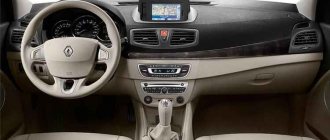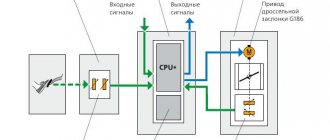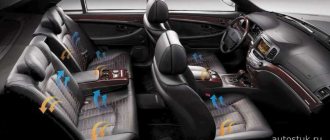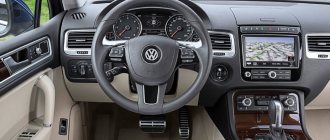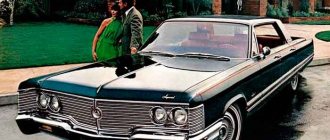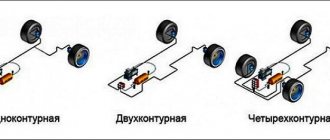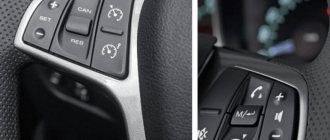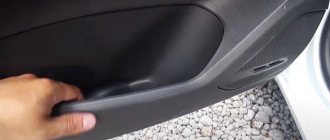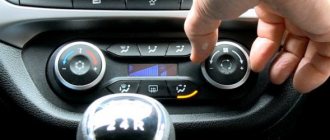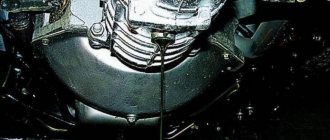26.02.2021
Conventional cruise control allows you to maintain a given speed, which allows the driver not to use the gas and brake pedals and, as a result, reduces fatigue on long trips. Adaptive cruise control is, so to speak, a new stage in the development of cruise control. It allows you to set not only the desired speed, but also the distance to the vehicle ahead. If another vehicle enters your lane, Adaptive Cruise Control will automatically apply the brakes to maintain the set distance, and once the vehicle has moved far enough away or left your lane, it will accelerate again to the speed you set. More advanced systems use a navigation system and/or cameras to help the vehicle slow down on sharp turns and stay within the posted speed limits.
Like other safety and driver assistance systems, adaptive cruise control is not perfect and has certain limitations. If the car is not equipped with a semi-autonomous driving system, you will have to steer yourself. In this case, the driver is also responsible for emergency braking and avoiding obstacles. Adaptive Cruise Control uses cameras and sensors to determine the distance to vehicles ahead, so dirty or deteriorating weather conditions will negatively affect the operation of Adaptive Cruise Control.
What is adaptive cruise control? Purpose, features of work
The first cruise systems were created not for cars, but for steam engines, at the turn of the 17th and 18th centuries.
They began to be applied to cars only at the beginning of the 20th century, and acquired a relatively modern appearance only after the outbreak of World War II. Chrysler showed the world the first car with cruise control in 1958, however, already in 1965, American Motors updated the system with a modern twist. However, due to the oil crisis of 1973, the economy declined and interest in new technologies decreased. Only with the advent of the 80s did car enthusiasts begin to show interest in “autopilot”. Thus, in the 1990s, Japan developed adaptive cruise control, which not only maintains the speed of the vehicle, but also reacts to the dynamics of traffic in the stream.
ACC (adaptive cruise control) was created to make life easier for the motorist. The system, analyzing what is happening, can react and influence not only the operation of the engine, but also the operation of the throttle valve and brakes. Different models of adaptive cruise can be found on almost any type of car: from a station wagon to a sports car.
Despite the fact that many drivers still cannot fully trust electronics, adaptive cruise control is a fairly useful feature in the pace of modern life. Using special settings, ACC can independently control the safe distance from other road users.
Accessories
The system consists of three components:
- Distance sensor. There are two types of devices commonly used: radars or lidars. The former are more expensive and are used for business class vehicles. They operate using electromagnetic or ultrasonic waves. By measuring the wavelength, the sensor reacts to surrounding objects. Lidars operate using infrared laser radiation, but this makes them more susceptible to weather influences. Typically, several such sensors are provided at once to eliminate errors. The range of action reaches 150 meters, but there are devices aimed at a narrow range of action or at a longer range.
- Control block. The ECU receives measurements from sensors and devices of the vehicle. Thanks to this, the ECU calculates and analyzes the distance to the nearest obstacles, lateral acceleration, vehicle speed, and the magnitude of the curve.
- Additional software. Adaptive cruise does not have separate control systems, but for similar purposes ACC uses some vehicle systems, for example: automatic transmission, electronic throttle drive, and directional stability system.
Device
The ACC system contains its own components and devices, and also uses those already available in the car:
- radars or lidars for obstacle detection with different ranges, with RF sensors working better in conditions of limited visibility, precipitation or fog;
- accelerator pedal activator or electronic throttle;
- microcomputer system control module;
- sound and light indicators, information board and control panel with buttons;
- communication interfaces with ABS and ESP systems;
- brake and accelerator pedal sensors.
The basis of the device is a control program containing all the complex algorithms for the operation of the ACC in various conditions.
Adaptive Cruise Capabilities
Compared to a regular cruise, ACC has wider functionality. If the first models could only maintain a given speed, then new systems are able to independently regulate the dynamics of the vehicle. For example, when driving downhill, adaptive cruise control changes the throttle opening range for safer and more optimal driving, while adjusting the speed and load on the engine. Accordingly, when moving down, a reverse reaction occurs.
The main feature of the new cruise, which is actually reflected in the name, is the ability to adapt to conditions on the road. Scanners are installed on the front bumper of the car, which analyze in real time the actions of nearby passing or ahead objects.
If the owner has previously configured ACC for a certain mode, the system will adjust the vehicle’s operation to the specified parameters. If the vehicle ahead accelerates, the vehicle with adaptive cruise control will automatically accelerate to maintain the specified distance. The mechanism also works in the opposite direction.
Mercedes was the first to use ACC on S-class cars.
What cars is ACC installed on?
Nowadays, ACC can be installed on almost any car as an option, although it is most often found in the premium segment.
This is due to its rather high cost. A good set will cost 100-150 thousand rubles.
Each car company has its own brand names for essentially the same system with minor changes in controls.
Traditionally, ACC may be called adaptive cruise control or active cruise control, or more individually using the words "radar", "distance" or even "preview".
The system was first used in Mercedes cars under the Distronic brand.
Operating principle and varieties
Adaptive cruise starts at approximately 30 km/h and continues smoothly up to 180 km/h. More expensive models are capable of operating immediately after starting and up to a threshold of 200 km/h. Separately, in heavy traffic conditions, the StopandGo option works.
When slowing down or moving from lane to lane, the vehicle speed decreases to maintain distance. At low speed it is ensured by operating the brakes (reducing the pressure of the fuel fluid), and at high speed - by reducing the load on the engine (adjusting the amount of air supplied to the throttle valve).
Fuel economy thanks to the adaptive cruise system will be a pleasant bonus. According to reviews, savings range from 1% to 5%.
Since the system is connected to common electronics, ACC uses data from preventive safety, GPS, and braking to increase safety. To obtain vehicle speed data, radar emits electromagnetic waves. The speed is determined depending on the frequency of the reflected wave. The distance can be determined relative to the echo's return time. After the radar receives data, the information is converted into electrical signals for transmission to the ECU. Afterwards, the control unit transmits “instructions” to the brakes, ABS, EBD, ESP and the engine.
There are several types of cruise control:
- Classic cruise control. Maintains only the set speed, but does not control the safe distance.
- Adaptive CC (cruise control). Reacts to changes in traffic density, distance, speed and operation of vehicle nodes.
- Semi-autonomous. Considered the second generation of adaptive cruise. Unlike the first, the semi-autonomous SS can intervene in the steering. However, a semi-autonomous system cannot be considered perfect, since the system is still not able to see all the objects around it.
- Speed limiter. Despite its small functionality (maximum speed limiter), it is considered a subtype of cruise control.
System control principle
Activation and deactivation of adaptive cruise control is controlled by the driver using a control panel that is usually mounted on the steering wheel.
- You can turn the system on and off using the Power and Power buttons respectively. If they are not there, the Set button is used as a replacement, allowing you to activate cruise control. The system is switched off when the brake or clutch pedal is pressed.
- You can set the parameters using the Set button. Once pressed, the system sets the actual speed and continues to maintain it while driving. Using the “+” or “-” keys, the driver can increase or decrease the speed by a set value each time they are pressed.
ACC operation control switch
Adaptive cruise control is activated at a speed of at least 30 km/h. Uninterrupted operation is possible when driving at a speed of no more than 180 km/h. However, some premium-segment models are capable of operating from the moment they start moving up to a speed of 200 km/h.
Advantages and disadvantages of ACC
Cruise control as a whole is a new and quite convenient electronic system. However, like any other automotive electronics, it has a number of disadvantages and advantages.
- Firstly, adaptive cruise control allows you to save fuel.
- The system also allows you to relieve the driver of the burden of constantly having to regulate the speed of the vehicle.
- Thirdly, the system provides a good level of security and quick response in case of an emergency.
Among the shortcomings, two groups can be distinguished:
- Purely technological. They consist of malfunctions of sensors and oxidation of contacts. If the radars malfunction, the system may by default assume that there is an obstacle ahead of the vehicle and reduce the vehicle’s speed almost to a stop.
- Mistrust on the part of drivers. Since a high level of automation relaxes drivers, the level of attention to the perception of changes while driving is consequently reduced. As a result, the motorist cannot react with the proper speed to an emergency situation.
Cost of the complex
Now it’s clear what cruise control is in a car. This is a driver's assistant, sometimes quite effective. But these systems are not standardly installed on all car models. If the machine is not equipped with such a system, you can install it yourself or from an authorized dealer.
As for the cost of the system, it all depends on the make of the car. So, for BMW models, such a complex can cost from 100 to 150 thousand rubles . This does not include the price of wiring and internal monitor. You should also add the cost of installing adaptive cruise control.
Used kits can cost an average of 1,200 euros. But here’s the advantage: the kit is already as complete as possible. There are pitfalls though. For example, there is no guarantee that this option will work as usual.
Setting up the system requires a lot of effort and special knowledge. The radar for the system costs several thousand rubles, the most expensive thing in such systems is the control unit. Read also: How to wash the valve body of an automatic transmission with your own hands?
As you can see, the described system is an expensive pleasure, but when buying a modern car, it would not be a bad idea to equip it in this way. Those who often find themselves stuck in traffic jams or traveling long distances will appreciate the usefulness of this equipment.
How to use adaptive cruise control
The driver controls the operation of the cruise control using a paddle on the steering wheel or dashboard. There are two types of cruise control: with and without maximum speed limiter.
To turn on the system, just hold down the corresponding key when reaching maximum speed. The current speed is saved in the device memory. At the moment when the indicator of the vehicle in front lights up on the display, the driver can select the value of the distance between the vehicles. You can change the indicators using the corresponding “+” and “-” buttons. You can monitor your work using color indicators on the dashboard.
You can evaluate all the advantages and disadvantages of ACC by watching some videos on the Internet, for example:
